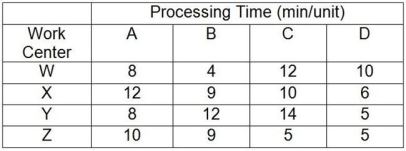Table 5.2
A company makes four products that have the following characteristics: Product A sells for $75 but needs $20 of materials and $20 of labor to produce; Product B sells for $90 but needs $45 of materials and $20 of labor to produce; Product C sells for $110 but needs $50 of materials and $30 of labor to produce; Product D sells for $135 but needs $75 of materials and $40 of labor to produce. The processing requirements for each product on each of the four machines are shown in the table.

Work centers W, X, Y, and Z are available for 40 hours per week and have no setup time when switching between products. Market demand is 50 As, 60 Bs, 70 Cs, and 80 Ds per week. In the questions that follow, the traditional method refers to maximizing the contribution margin per unit for each product, and the bottleneck method refers to maximizing the contribution margin per minute at the bottleneck for each product.
-Use the information in Table 5.2. Using the traditional method, which product should be scheduled first?
Definitions:
Financial Decisions
Choices made regarding the management, investment, and utilization of funds within an organization.
Behavioral Finance
A field of finance that proposes psychology-based theories to explain stock market anomalies.
Reasoning Errors
Mistakes in logical thinking or incorrect conclusions drawn from evidence or assumptions.
Financial Decisions
Decisions made by individuals or companies relating to managing money, including investment choices, budgeting, borrowing, and saving.
Q14: _ is the maximum rate of output
Q30: What is a waiting line model,and what
Q37: Briefly outline the steps to be followed
Q48: What are the general operating rules for
Q69: The rack at my assembly station that
Q123: Use the information in Table 5.3.Using the
Q130: A back office operation most closely resembles
Q140: What did the production manager say to
Q144: Process improvement teams that focus on processes
Q166: In a service process,capital intensity varies with